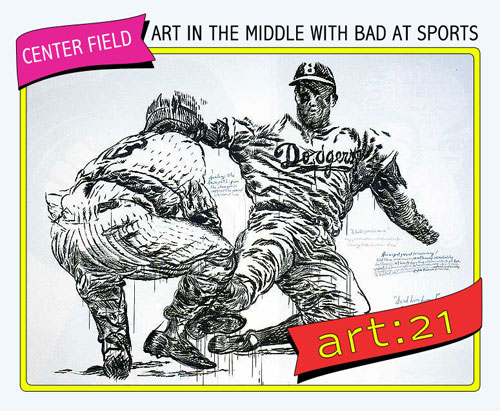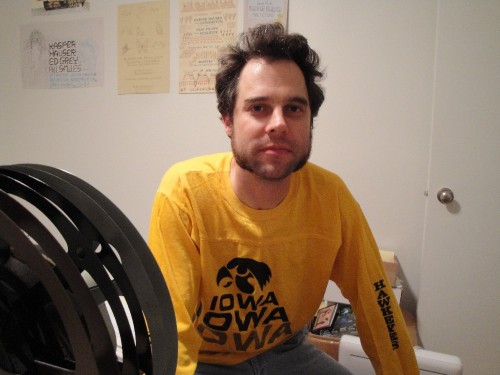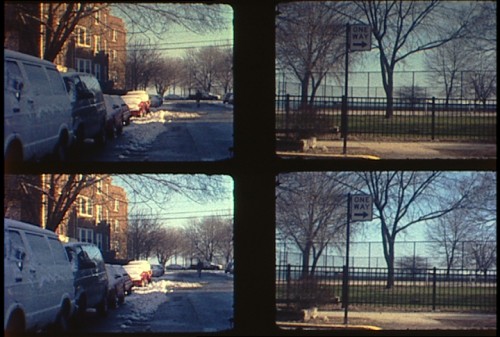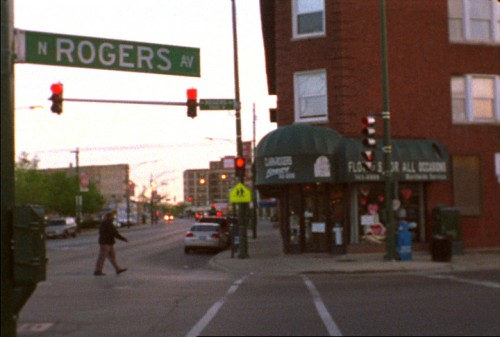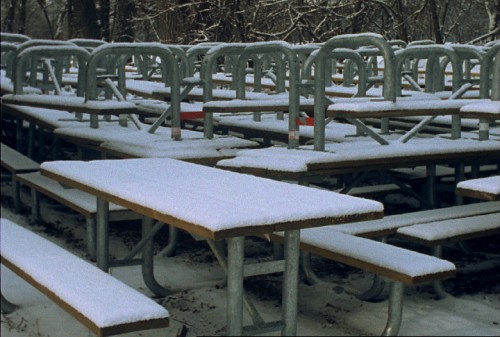Thomas Comerford is an experimental filmmaker from Chicago with a background in performance and sculpture. His current work considers ideas of place, and the relationship of history to our physical landscape. His newest work, The Indian Boundary Line, explores the history of this artificially created boarder that once divided the Louisiana Territory from Indian Country.
Terri Griffith: When I think about your early work as a filmmaker, your work seems more experimental. But this latest piece, The Indian Boundary Line, is more narrative and seems less like it would be shown in a gallery.
Thomas Comerford: The majority of the work I did in graduate school was very open ended. I really did look at filmmaking as science. So in order to do this project, I’m going to set up this structure in order to see what happens. The end-product will be an assembly of its results. I couldn’t even necessarily articulate that at the time, but when I look back and think about those films and how they play out, that’s exactly what they are. I did a film that dealt with the palindrome as a structure but taking it from written language and applying it to a film strip and recorded sound. So there were all these segments in that film, which I made in 1997, that went forwards and backwards.
The first pinhole movie I made was simply, Okay, I have this pinhole camera. I have these locations and I have these gnarly low-fi sound recorders. So I’m just going to film in these places and see what happens. The assembly of something like that is very different. But once I moved from that, narration has been pretty important to a number of my movies, even if it’s been kind of oblique. It’s a layer I like to work with to reflect what’s going on. I like to always put things together to allow for some kind of consideration, to be mulled over. It’s something I keep returning to.
There’s a film I made in 2005 that deals with a lot of the same issues as this movie The Indian Boundary Line. It’s called Land Marked/Marquette. But for that film, I really tried to break away from voiceover. So there’s only one voiceover in the movie and that’s an interview I edited to accompany some pictures. That film dealt with the history of Chicago as well but more explicitly with the legacy of Marquette–the Jesuit priest who came through here. More explicitly it dealt with monuments. Monuments are certainly a concern of the new film but they are considered alongside many other things. Whereas Land Marked/Marquette was preoccupied with monuments as public history and how strange these things are in relation to their surroundings. And also how history gets articulated at a very particular moment in time and represented, but then it’s sort of permanent.
TG: Like The Indian Boundary Line?
TC: Exactly.
TG: When I was watching this film, I had a hard time imagining the starting point. It seems impossible to storyboard and there is obviously a lot of research. Still, some of the shots seem so organic that I thought perhaps the work could have grown from there. So where do you start?
TC: There’s been a series of films I’ve made that deal pretty explicitly with Chicago. There was Land Marked/Marquette and then there was a piece I made in 2003 that ended up being my last pinhole movie called Figures in the Landscape. It was about Schaumburg. Even though each of those films was carried out somewhat differently, what drove them, which is different than some of my earlier work, where I had these scientific ideas about what I wanted to talk about–Here’s an idea: The palindrome and I’m going to use it as a way to conduct experiments–with these films, the genesis, the initial inkling came from wandering, from being out and about, from wandering through landscapes and thinking about the design of land, and what are the kinds of things that have shaped why things look the way they do. It was the first thing to cause me to actually deal with Rogers Avenue. It’s so weird. Why is this road even here? Chicago is one of the most notoriously rigidly gridded cities around, right? Everything is North, South, East, and West. All of the numbers make sense. There are some diagonal roads, but all of them come out of downtown, following what might have been paths or early roads. These diagonal roads fulfill these functions even prior to European settlement. I mean, these were paths. So when I encountered this road, as just a person walking around, and thinking This is weird. This is a diagonal road, but it’s not like any other diagonal road in Chicago. It starts at the lake, and then travels Southwest to no place in particular. I forgot about the road for a while, but when I was doing research for another film and I came across a book of treaties which impacted this area. So I started looking at them and that’s when I put it together–that’s a diagonal shape created because it was a surveyed line when a treaty was signed in 1816. That was really fascinating to me when I discovered it. So the initial spark was just really driven by curiosity.
But as I started learning a little more about that road, and the not road, what I started thinking about was–the film’s opening text–I started thinking about commemoration. Frank Grover, an amateur historian, talks about the importance of commemoration. I became interested in how fragments of events, of personalities, or institutions get imbedded in the landscape. That fed into the archival research that I did for the film, a lot of which I did at the Newberry Library. But then that re-fed into the exploration of the land. I was interested in the film being virtual, because film is great that way. It’s this great replication of how we see and hear. Part of the film that was important to me was to actually follow this line, and all of the spaces I visit have some kind of commemorative–I mean the whole line is commemorative in a way–but there are spaces that via language, or memorial, or whatever, have a relationship to that historic event. They either commemorate a Native American tribe or the boundary itself.
TG: Oh yeah, like Chippewa Playlot and Potawatomi Park and the historic marker on that building behind the traffic signal control box.
TC: Have you looked at that marker in person?
TG: I haven’t been by there since I saw the film. But who knew that was a significant historic sight because there’s a Walgreens across the street!
TC: This was an idea I had that I never figured out how to deal with in the movie so I sort of let it go, but one of the texts I was looking at talked about how there was a Native American village where that Walgreens is. I wasn’t quite sure what to do with that because it didn’t quite fit with what ended up happening with the film.
TG: Well, let me ask you about that. Being a good artist means making choices. So how do you let go of something as significant as the fact that where that Walgreens is there used to be a village of Native people and now it is a weird, terrible corner.
TC: There were a lot of ways this could have gone but one thing that became significant was that there was almost this literal thing that I wanted to do. The Walgreens story was interesting, but different. Because all these other spaces that I explore have a very explicit connection to the treaty. In the end, I decided I had to stick with that. I’m still interested and there were other ways that those ideas came into play. When I found the Black Hawk autobiography, the excerpts that I chose to work with from that, very eloquently expressed some of those very same ideas. I wanted the structure to be very clean. I like form. I’m a songwriter too and it’s the same way. I don’t mind if things are a little looser in execution, but I like the form to be very solid. The film has some looseness to it as well, but we’re always returning to the map. We’re always returning to the line.
TG: I like the looseness and I feel like all of that happens with the viewer and not really with the filmmaker because much of the film is static shots that seem really long and are really just beautiful.
TC: Most of those shots are 20 to 30 seconds.
TG: The thing that was surprising is how many parks and open spaces are located on The Indian Boundary Line. As I was watching I thought that if you didn’t tell people, they would never know this was filmed in Chicago. The only thing that gives it away are the airplanes flying overhead. We’re on the flight-line to O’Hare. But really, those shots are long enough to lose yourself in them, but then literally, you bring the viewer back to a spot on the map.
TC: You’re right. Everything is pretty gridded-out, but the looseness happens experientially, because I am giving you opportunities to consider things. It’s happening in a visual way. I’m placing written, performed texts in relation to images. And you can accumulate that and think about that in relation, but the actual construction of the spaces is often pretty immersive as well. There’s a certain amount of detail that I’m interested in creating, so you do get a sense of space. Like, This is what this space sounds like. These are the kinds of things that are happening there. On top of that, there’s a particular variety that I’ve sought in the particular kinds of writing that is being articulated. But the way I am using that writing is to draw out the ways in which people are thinking about land, the design of land, and the settlement that has, or was, or is happening.
TG: Even though it contains writing, it’s not your writing. I thought that was interesting when the film started we very clearly get this voiceover narration, where you are setting things up. I thought it was going to continue along those lines, but it didn’t. Most of the texts are historic works and then you reading your placement of where you are along the Boundary Line. I thought that was really beautiful and compelling.
TC: It is my thing. The film is my voice, I don’t want to disguise that. Part of it is there’s a process of discovery that I went through when I came across these things. This is something that I’ve thought about just recently, but part of the film is trying to re-create that. To me it’s a process of collage. There’s actual writing, and I think of writing as media. But there’s other media too. There’s a soundtrack that I lifted from a film. It’s over at Chippewa Park and it’s an interview with a police detective. It’s an optical track from a 16mm film. And then there’s this more present moment when I’m, well it’s performed, but where I’m reading GPS co-ordinates from an iPhone.
These little, everyday things, pieces of written and recorded media, things that have happened within this large cultural enterprise of nation building or the construction of the United States are all little nodes of expressions about it. I feel like it’s all just there and I want to put these things in relation to each other. Grabbing these bits and pieces and trying to create a productive relationship between them, but also thinking about it as a temporal work. There’s a lot of investment in you seeing things in a particular order. It’s the same way with reading a novel. You’ve accumulated this information and subsequent things you experience take you back or bring other things forward. I like the idea of finding these things as opposed to completely creating something from scratch.
TG: Much of this piece looks like it was filmed on Super-8 but I wasn’t sure about the rest of the film. Some looks 16, some digital. Tell me about that.
TC: Well, it’s all film. The section of the path, that was all shot on Super-8. Then there’s a section that’s constructed very consciously like a home movie. Everything else, with the exception of the opening sequence and the closing sequence, everything else is 16. The opening and closing sequence is regular 8. The way those cameras were constructed, you shot half of the film at a time and then you flipped the film over and exposed the other half. And back then people would take their film to the lab and the lab would actually cut the film in half, tape it together and send your film back in one strand. I was interested in that structural image.
For me it’s about pride and craft, and using my wherewithal as a film photographer to try to be creative about using materials. My knowhow and creative interest in using the materials to take pictures of these places. There were no effects at all. Everything was done just with cameras. I would have preferred to have finished this as a film, meaning a print. But that’s just getting really hard to do financially. I did get a variety of small grants to support this project, but at the end it was a question of, to finish this I can either spend a thousand dollars or five thousand dollars. Because of this, it ended up as film in digital–a hybrid piece. But one where I tried to preserve the film’s qualities. Some might argue that it would be interesting to really push the digital technology, but for me I was really interested in…The moment for me when it’s happening is when I take the picture. The construction of the film tries to support that. I decide on an order, and I decide you know, two more seconds of this, two less seconds of that, five more seconds of this. The structure of the film supports that too. It’s very intentionally linear. It’s like, I’m here and here are the pictures I’m taking. Now I’m here…That comes, I think from more out of an interest in photography, a practice. Especially photographers that deal with place.
There’s a guy from Memphis originally, William Eggleston. I think his stuff’s brilliant. He mainly deals with the south. There’s another photographer Lee Friedlander, who’s done a variety of different work. But there was series he did on monuments, in the 60s, I think. Then he also did a series more pertinent. Something that influenced me when it came to thinking about what I was thinking about. He did a series of photos over the course of his career on Frederick Olmsted, the landscape architect. I’ve read a bit of Olmsted’s writing and I’m interested in Burnham as well, and other people who have been involved with the way we think about the design of land. My approach, even though it’s a film, the way I’m thinking about images is more like that of a photographer. So everything I do is to support that moment of the picture being made.

